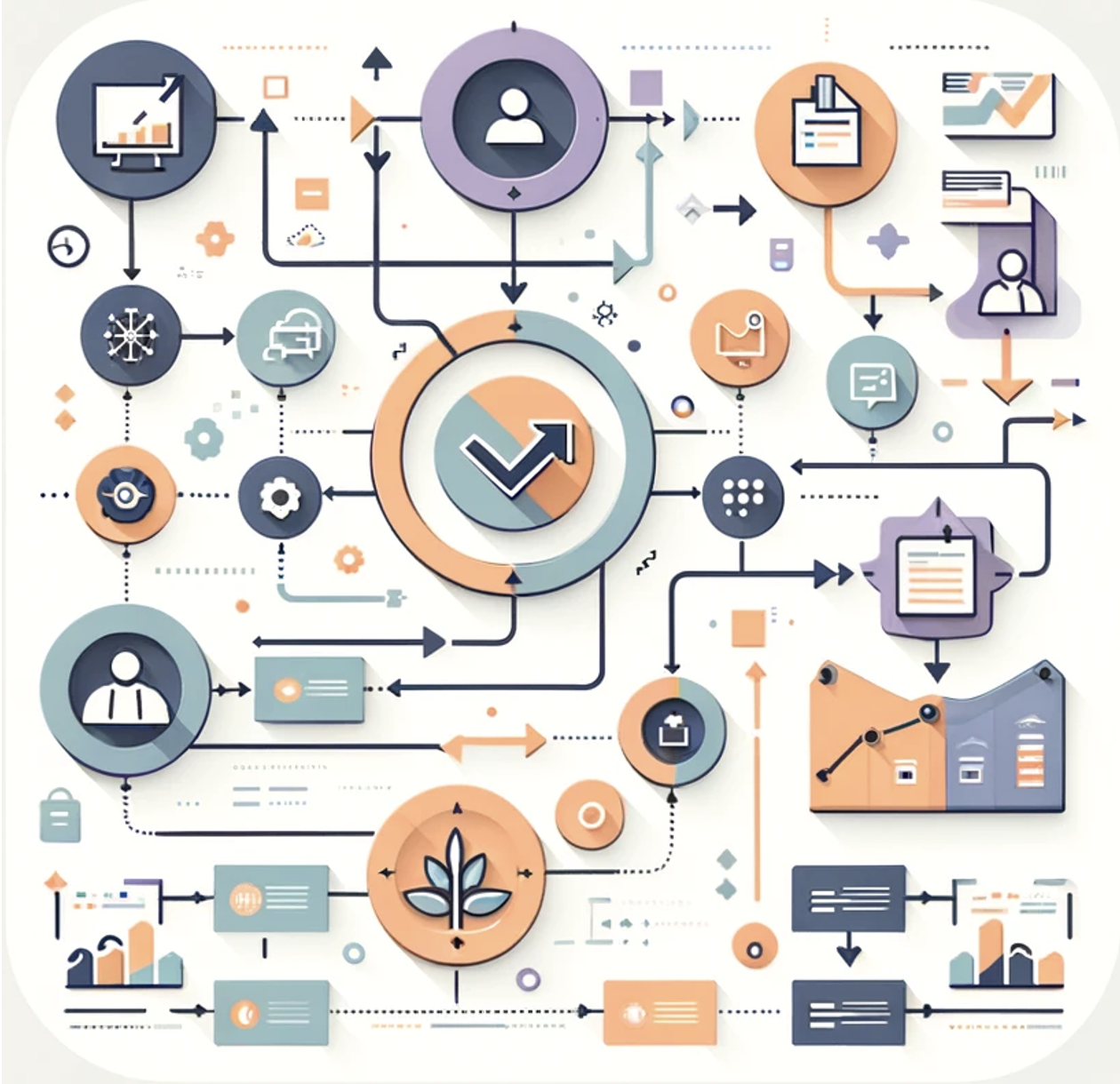
Ever feel like there are not enough hours in a day? You're flooded with emails, your co-workers won't stop interrupting you, and a big deadline is looming. A good workplace workflow is the key to boosting productivity while reducing stress. But, really, how do you pull off that seemingly mythical level of efficiency? Never fear because this guide is chock-full of practical tips to step up your game in improving workflow efficiency and finally get that to-do list tamed.
Why Workflow Management is Important for Your Company
Each department and each worker is a simple efficiency building block of the company. Yet, all that is carefully built might be turned completely ineffective in the face of a bad design of the workflow, and the whole system goes down the drain. Workflow is the essence that adhesively holds all the functioning parts together, avoids delays, and ensures the attainment of goals.
Here's how to improve workflow in the office for your business:
- Growth productivity. Harnessing common best practices and crystallized workflows avoids chaos and the unnecessary waste of time. They all know exactly what to do, when, and in what manner. It limits errors, cuts down cycle times, and enables your employees to focus on important tasks. Companies using workflow management gain, as indicated in the Aberdeen Group study, about 20% increased productivity with it.
- Teamwork. An accumulation of such productive workflows has broken down walls between departments and made much better coordination possible. Employees are to understand themselves as one part of the whole process, which results in better communication, knowledge sharing, and (ultimately) creativity in problem-solving.
- Improving customer satisfaction. Proper workflows allow for happy customers. From a broader perspective, the timeliness of a project, low error rates, and well-set expectations from the beginning may greatly contribute to an enhanced customer experience. That way, you can be sure that the customer trusts you, makes another purchase, and is likely to recommend you to others.
- Cost-effective. Ineffective workflows are costly. These are irritative behaviors: misunderstandings, doubling the work, and lagging behind deadlines that for sure end up in a fiasco. Workflow management brings about efficiency in procedures, which then rubs out the cracks of inefficiencies, reduces costs, and saves time.
- Empowered employees. In turn, the clarity of work processes provides the employees with a leading position that empowers them to assume independently what is wanted of them and not derail from it. They are conscious of their roles to help the organization accomplish certain aims, and this incites and further increases job satisfaction.
- Scalability and growth of your company – so will your positions. Exact workflow builds up a base for scaling your enterprise. With already built-up processes, you can incorporate new employees into your crew in no time and maintain a high level of performance.

How Office Workflow Affects Productivity
An inefficient and badly established workflow tends to take a long time, irritate workers, and even increase the number of missed deadlines. The WRQ Consortium found that when the workflow couldn't adjust to the needs of work, between 20 to 30% productivity loss occurred. That really is a significant portion of sales routes! The reason that an efficient work process is more than just a nice feeling is that it brings good things to your balance sheet.
Top Tips How To Improve Workflow
Does your workday ever feel like an endless street fight between bulging inboxes, missed deadlines, and never-ending to-do lists? Be sure to add in these top five key strategies that will help turn your office from a chaotic cyclone into a productive powerhouse.
Encourage a healthy work-life balance
An employee who is burned out can create a contagious atmosphere that can affect the productivity of the entire team or organization. So, this is the place where the question appears: how to improve workflow? First, you need to create an atmosphere in which appreciation is given for private life and free access to rest breaks. Second is creating time for your mind to recollect and sharpen; physical separation of mind and desk might be good when you come back.
Therefore, it is a matter of maintaining a balance through juggling between one's work and personal activities in order to sustain productivity. For instance, imagine a work setting in which the employees feel safe to follow the rules of self-care and have a clear demarcation of work from personal life. Workable solutions have been proven useful for workers in increasing the balance of work and personal life, therefore decreasing burnout.
Always strictly forbid your workers to work late if it is absolutely unnecessary and there are no relevant issues or problems to take care of. One should reckon with the fact that turning off lights in a company, for example at the end of a working day, is a sign that illustrates the end of work. Best behavior at that, people might actually make their best only in this way; it is not the number of hours that matter, but efficiency and results that these hours are worth. Healthy habits are an encouragement you should not forget. The highest peak of physiological wellness is when a person is at his or her best mentally.
Implement Proper Training
Training the employees is another avenue through which the company should be investing in the future. Ensure the employees are trained and know when and where they are needed. These may include software tutorials, communication workshops, or training programs intended for industry specialization in such areas as agriculture, manufacturing, and service.
One key aspect is the confidence and skills of an employee. Trusting employees will probably be more productive. Develop several kinds of training for every team member or department. This may consist of master classes on newly introduced software for a newly hired employee, communication courses for a team that faces issues with good cooperation, and professional educational programs to keep the team up-to-date in their professional sphere.
Reach every learner by employing a variety of training styles. This could be in the form of an online course, face-to-face workshops, email/video/phone exchanges with staff, and even mentoring schemes in which senior staff members pass their skills on to recruits.
The best software and tools to improve office workflow
That is an effective instrument for you to win over inefficiency. Use project management tools that will help you with organizing teams and time, for example, Asana or Trello. Use communication technologies – Slack, Microsoft Teams, Zoom – to make it easier to share information and collaborate. The right software will automate routines so more time can be opened up for strategic work.
You can even use Zapier or IFTTT to stitch together workflow automation, where many applications come to be linked with each other, but without human data entry. Also, for boosted email communication and outreach, you might want to plug in a solution like AImReply. This powerful solution will in seconds generate highly personalized emails and replies, not only saving you hours of your daily work (and thus enhancing your productivity), but also helping in become more efficient thanks to the built-in advanced GPT technologies that enable creating high-quality emails tailored to all possible occasions.
The combination of such technologies enables a fine-tuned tech stack that fits the workflow of the team perfectly, enabling them to reach peak productivity.
Stop multitasking
It may seem that the killer is doing a lot of different things at once, but studies have shown that this is not the case. Multitasking does not allow us to capitalize on our potential. In fact, it can decrease productivity by up to 40%. Instead of splitting your time between various tasks, focus on finishing one. Build batches of similar tasks to avoid context switching. This is a major factor that discourages focus.
So, how do you release the multitasking trick? Here are some practical strategies that will help you improve the workflow process:
- Embrace single-tasking. Plan and schedule your activities on a timetable, and don't let distractions get in the way of your attempts to concentrate at that time.
- Batch similar tasks together. Cluster tasks with affinity into one group to cut the associated transition time.
- Silence distractions. Turn off notifications on your phone or computer while you're working on a task that requires concentration. Use website blockers or noise-canceling headphones to reduce the distracting effect that external factors have on your work.
- The Pomodoro Technique. This response time planning system bundles 25 minutes of intense work with short breaks. Use mindfulness techniques to avoid wandering off and achieve concentration for longer periods.

Clearly communicate tasks and processes
It is crucial to use clear and concise language in order to ensure a smooth and efficient workflow. When all team members understand their roles, duties, and project goals, the communication chain is complete. How to improve workflow efficiency? Who is responsible for what? It is important to clearly define responsibilities among each team member. This will ensure that everyone is aware of their role and can contribute effectively.
It is also beneficial to create a list of well-written and easy-to-follow instructions for each task or process. This will help to streamline communication and ensure that everyone is on the same page. This can range from simple flow charts/step-by-step guides to downloadable videos and tutorials. Open and readable language is the vital element of a trouble-free workflow. The perfect chain will be made when all team members understand their roles, their duties, and the project goals outside being immediately attainable.
Use the most effective type of communication in your style. Team meetings are for project updates, emails are for detailed information sharing, and instant messaging platforms are for quick and easy updates and responses. Make the team members feel safe by being open to their suggestions, points of concern, and improvisations on workflow.
How Little Things Can Have a Big Impact on Office Productivity
These "how to improve workflows" strategies are powerful. We guarantee you'll be impressed with how they transform your office workflow into a chain. They'll help your company overcome setbacks and achieve significant success. Remember, the little things often make a huge difference.
Share this post
Leave a comment
All comments are moderated. Spammy and bot submitted comments are deleted. Please submit the comments that are helpful to others, and we'll approve your comments. A comment that includes outbound link will only be approved if the content is relevant to the topic, and has some value to our readers.


Comments (0)
No comment